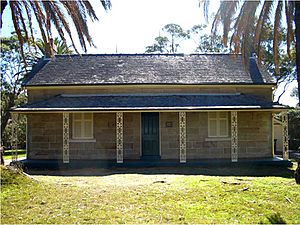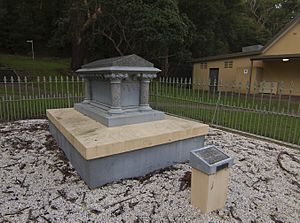Carss Cottage facts for kids
Quick facts for kids Carss Cottage |
|
|---|---|

Carss Cottage, pictured in 2005
|
|
| Location | 80 Carwar Avenue, Carss Park, Georges River Council, New South Wales, Australia |
| Built | 1865 |
| Built for | William Carss |
| Owner | Georges River Council |
| Official name: Carss Cottage | |
| Type | State heritage (built) |
| Designated | 2 April 1999 |
| Reference no. | 587 |
| Type | Cottage |
| Category | Residential buildings (private) |
| Builders | Scottish masons |
| Lua error in Module:Location_map at line 420: attempt to index field 'wikibase' (a nil value). | |
Carss Cottage is a special old house located in Carss Bush Park in Carss Park, Sydney, Australia. It was built in 1865 by William Carss, who was a cabinet maker. Today, it is a historical museum where you can learn about the past. The Georges River Council owns this important property. It was added to the New South Wales State Heritage Register on April 2, 1999, which means it is protected because of its historical value.
Contents
The Story of Carss Cottage

Carss Cottage stands on land that was first given to Jonathan Croft in 1853. This land was about 119 acres (48 hectares). Croft sold the land less than a year later to William Barton. The land was sold a few more times over the next two years.
In 1863, William Carss bought the 119 acres (48 hectares) of land. William Carss was a skilled cabinet maker. He had moved to Sydney from Glasgow, Scotland, in 1831. He worked as a main carpenter for important buildings like Lyndhurst.
It is thought that Carss Cottage was finished by December 1865. William Carss then moved to the area. People believe that Scottish stonemasons built the house. These masons had also worked on the University of Sydney buildings. The stone used for the cottage was reportedly dug up right from the land nearby.
William Carss passed away in 1878. His daughters, Mary and Anne, inherited the property. Later, Mary became the sole owner. When Mary Carss died in 1916, she left the cottage to the Sydney Sailors' Home.
In the mid-1920s, the Sydney Sailors' Home sold the property to the Georges River Council. The land was then split into two parts. About 50 acres (20 hectares) became Carss Bush Park, which opened in 1924. The rest of the land was divided into smaller lots for houses.
The cottage itself was given a new purpose. It became the home for the park's ranger. Joseph Harald Coxhead was the first ranger, living there from 1924 to 1953. Over the years, some changes were made to the cottage. Old sheds were taken down, and the inside was updated. Stone walls, an arbor, and stone seats were added to the garden in the 1930s.
In the late 1960s, people became very interested in history. The Georges River Council decided to turn Carss Cottage into a historical museum. This allowed people to visit and learn about the area's past.
What Carss Cottage Looks Like
Carss Cottage is built with strong sandstone walls. It has a roof made of slate.
Condition of the Cottage
The cottage is in good physical condition today. There is also a good chance of finding old things buried where the original outbuildings used to be.
Changes Made Over Time
- 1865: The cottage was built.
- 1924: The land was divided, and the cottage became the park ranger's home.
- 1928: Old outbuildings were removed, and the inside of the cottage was changed.
- 1930s: Landscaping work was done, including building stone walls, an arbor, and stone seats.
Why Carss Cottage is Important
Carss Cottage is a very important historical site. It is one of the oldest buildings in southern Sydney, especially south of the Cooks River. It is the oldest building in the Kogarah area and shows how the area first grew.
William Carss was a respected craftsman in the 1830s. He even helped start the Sydney Mechanics School of Arts in 1834. The cottage is a rare example of a stone house from the mid-Victorian period in southern Sydney. It sits on a small hill near Kogarah Bay. Its natural setting adds to the beauty of the bay area.
Carss Cottage was added to the New South Wales State Heritage Register in 1999 because it meets several important rules:
- It shows the history of New South Wales: It is one of the oldest buildings in southern Sydney. It is the oldest in the Kogarah area and tells us about the early days of the region.
- It shows great design and skill: It is a rare example of a stone house from its time. Its location and natural surroundings make it a beautiful part of the bay.
- It is rare or uncommon: It is the oldest building in the Kogarah area and one of the oldest in southern Sydney.
See also
- Australian residential architectural styles

